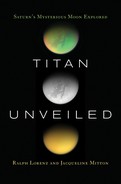Further Reading
The development of the mission, and of our understanding of Titan, is described in our own book, Ralph Lorenz and Jacqueline Mitton, Lifting Titan’s Veil, Cambridge University Press, 2002.
An earlier, more academic book, which gives particular emphasis to spectroscopy, is Athena Coustenis and Fred Taylor, Titan: The Earth-Like Moon, World Scientific, 1999. A considerably improved and updated Second Edition, entitled Titan: Exploring an Earthlike World, was published in 2008 and is highly recommended.
An excellent overall description of the Cassini mission as a whole is David M. Harland, Mission to Saturn, Springer-Praxis, 2003. (A new edition, entitled Cassini at Saturn, with more than one hundred additional new pages, was released in 2007.)
A recent management book that derives some lessons from Cassini (with some interesting project history and many interviews with Cassini managers, scientists, and engineers) is Bram Groen and Charles Hampden-Turner, The Titans of Saturn, Marshall Cavendish Business, 2005.
ACADEMIC READING
To date, most Cassini findings have been published in short papers in the journals Science and Nature. More detailed analyses will be reported in these and in planetary science journals such as Icarus, Journal of Geophysical Research, and Planetary and Space Science. Many papers in these journals describe results from the cruise phase of the mission as well as Earth-based observations and theoretical models. A resource for searching for such papers is http://adsabs.harvard.edu/ads_abstracts.html.
Detailed descriptions of the Cassini instruments are given in papers in Space Science Reviews, Vol. 104 (2002) and Vols. 114 and 115 (2004). Huygens and its instruments are described in detail in A. Wilson (ed.), Huygens, Science, Mission and Payload, ESA SP-1177, 1997.
The earliest compilation of Titan science is D. Hunten (ed.), The Atmosphere of Titan, proceedings of a workshop held July 25–27, 1973, at Ames Research Center, NASA SP-340, 1974.
Voyager results at Saturn (with a long chapter by Hunten and others devoted to Titan, pp. 671–759) are discussed in the book T. Gehrels and M. S. Matthews (eds.), Saturn, University of Arizona Press, Tucson, 1984.
A detailed snapshot of Titan science at the beginning of the Cassini project is B. Kaldeich (ed.), Proceedings of the Symposium on Titan, Toulouse, France, September 1991, published by the European Space Agency as SP-338, 1992.
Another snapshot, just before Cassini’s arrival, which also includes an excellent set of historical papers on Christiaan Huygens and his various activities, is K. Fletcher (ed.), Proceedings of the International Conference: Titan, From Discovery to Encounter, April 13–17, 2004, ESTEC, Noordwijk, the Netherlands, published by the European Space Agency as SP-1278.
The findings of the Cassini mission through 2008 are given in an authoritative 500-page volume cowritten by dozens of Cassini scientists, entitled Titan from Cassini-Huygens, R. H. Brown, J.-P. Leebreton, and J. H. Waite (eds.), Springer, New York, 2009. Serious Titan scholars should start here.
ON-LINE RESOURCES
The usual disclaimer must be made that these sites were checked at the time the book was completed, but the Web is an ever-evolving entity, so site addresses and their contents may change or be withdrawn as time passes.
The first points of contact should be the JPL and ESA Web sites, which have large collections of images, movies, documentation, and products for educators, http://saturn.jpl.nasa.gov and http://sci.esa.int/huygens.
Many images can be found on the planetary photojournal, http://photojournal.jpl.nasa.gov.
Many informal compilations of Cassini results and news can be found on the Web. A particularly complete and well-informed collection is that of the Planetary Society, http://www.planetary.org.
A neat tool for your computer desktop is the Titan Sunclock developed by Mike Allison and colleagues at the Goddard Institute for Space Science, http://www.giss.nasa.gov/tools/titan24/.
The raw and processed science data from the Cassini mission can be obtained at NASA’s Planetary Data System, http://pdsimg.jpl.nasa.gov/Missions/Cassini_mission.html.
Huygens data are available at the ESA Planetary Science Archive, http://www.rssd.esa.int/index.php?project=PSA&page=index, and mirrored on the PDS, http://pds-atmospheres.nmsu.edu/data_and_services/atmospheres_data/Huygens/
Huygens.html.
Hubble Space Telescope data are available at http://www.stsci.edu.
The first author’s Web site is http://www.lpl.arizona.edu/~rlorenz.
